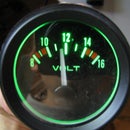Introduction: Cutting Jig for Breadboard/prototyping Wires (also for Heatshrinks).
Figured to share this rather simple yet helpful jig I made today.
It's simply just sticks laid base next each other on to create stops for different lengths for jumper wires which are then cut with flush cutters. This is still prototype so improvements might be coming in the future! It's ugly, but it works, so goal met here.
Addition: Afterwards i realized this jig is great for heatshrink too.
Step 1: Gather Materials & Tools
Materials & tools I used were common, and of course there's many ways to skin a cat. If you have 3d-printer/laser carver and other fancy stuff, of course you can use them, they are for use afterall. I don't have any of those yet, so gotta do with normal stuff :).
Enought of that, here comes small list and such;
Base: I used birch plywood, 33cm x 22cm 12mm thick.
Stops: First thought would be to use alder, but couldn't find anymore of it in storage, so used film veneer instead, not in picture here (15mm thick was what I used, seemed OK size)
Screws : Or nails, glue, whatever you might come up to for fixing stops in their place. I didn't use nails/glue just because in case I need to change/repair blocks. Screws are easier to take off and will hold block well in place. I used T-15 10mmx4mm.
Rulers: I used incra's t-square, bit expensive but well worth Its precision & quality. Keep in mind that we're tackling both inches and millimeters so pick tools according that. Longer ruler in picture has inch-scale too.
Pen: This is easily overlooked, there are many different pens but this is my pen....oops, military popped in mind hehe.
But, I've used many bad mechanical pens, what is good to look in pen is metal mechanism and that lead doesn't go inside pen when not pressed to do so; It's irritating in precision work when lead pumps up'n down like a spring....
Drills: Not in picture, but I recommend tower-drill due Its precision.
Step 2: Layout/planning
Any project without planning is most likely doomed.
Here's how I made layout & planning:
First I measured board for 15mm wide stripes for stops wideness, makes it easier to place stops.
Then comes bit harder part to explain, (or then I think too complicated), distance from jigs cutting-end is length of wire+0.5 inches. 0.5 inches is because there is 0.25 inches of insulation to be stripped at each end. There are 10 sections of 0.1 inches offset and rest 4 are 1 inches offset. To make your life bit easier, here's calculated values for stops (ratio how I calculated was wire length(in inches/;
Wire length (inches) Distance to stopper (inches/mm)
0.1" 0.6" (15mm)
0.2" 0.7" (17.5mm)
0.3" 0.8" (20mm)
0.4" 0.9" (22.5mm)
0.5" 1" (25mm)
0.6" 1.1" (27.5mm)
0.7" 1.2" (30mm)
0.8" 1.3" (32.5mm)
0.9" 1.4" (35mm)
1" 1.5" (37.5mm)
2" 2.5" (62.5mm)
3" 3.5" (87,5mm)
4" 4.5" (112.5mm)
5 5.5" (137.5mm)
Please tell if you see error! Highly possible as I'm used to metric.
Step 3: Making Stops
I could have taken more photos but garage I do stuff is cold and I had to make these quite quick, but I'll try to explain.
First, I cut plywood for set width, no need to worry about thickness as sections wideness comes thickness....just flipped block 90 degrees, makes marking screw holes easier too. And I didn't need weather-plating in this project.
First, cut plywood for your set width, 20mm in my case. Then cut them to be long enough, 7cm seems OK.
Now you have basic blocks, next to drill holes for screws. Mark screw holes as you see fit, I just used square's miter section.
This section can be overlooked, but I see many times screw holes that are made too small. Screw gives much better holding power if first hole it goes through is bit too big so it just drops in. Now screw's threads push object A to B, without losing strength to first object it goes through. Small thing, but matters a lot. Also, it can cause first object to rise or cause other strange stuff. If making starting hole, then hole must be stiff, just to mention. But in this case when object is tightened to another, first hole is bit larger. So if you have screw that has diameter from threads 4mm, make 4.5mm hole so it can wander freely in first object (I had to make 4mm hole as couldn't find 4.5mm) I know, that sounded like nitpick but figured to share this! :)
But before i forget, make shallow hole for screw long enough to make threads go through, I made them 17mm long (leaves 3mm for screw to stay on, well enough)
But, now blocks are done.
Step 4: Putting It Together
Almost done, only left to do is put things together.
Start by placing one block on side of base,as square as possible. I used spring clamp to hold it while tightening screws (Use-head first).Placement for blocks are those length marks you placed earlier.
This takes while, but the end-product is finished jig. Hopefully It is useful to me as it is for me!
To use it, just push wire to desired lengths stop block and snap it from the side-end .
Thanks for reading!











